Layered Structure Based on PANi and SiO2 to Absorb HPM to Protect Systems and Devices
Abstract
:1. Introduction
2. Design and Modeling
3. Results and Discussion
4. Conclusions
Author Contributions
Funding
Data Availability Statement
Conflicts of Interest
References
- Min, S.H.; Jung, H.; Kwon, O.; Sattorov, M.; Kim, S.; Park, S.H.; Hong, D.; Kim, S.; Park, C.; Hong, B.H.; et al. Analysis of Electromagnetic Pulse Effects under High-Power Microwave Sources. IEEE Access 2021, 9, 136775–136791. [Google Scholar] [CrossRef]
- Selvaraj, J.; Ware, D.; Dayanikli, G.Y.; Gerdes, R.M.; Gaunkar, N.P.; Mina, M. Electromagnetic induction attacks against embedded systems. In Proceedings of the ASIACCS 2018—ACM Asia Conference on Computer and Communications Security, Incheon, Republic of Korea, 4 June 2018; pp. 499–510. [Google Scholar] [CrossRef]
- Li, F.; Chai, C.; Wu, H.; Wang, L.; Liang, Q.; An, Q.; Yang, Y. Study on high power microwave nonlinear effects and degradation characteristics of C-band low noise amplifier. Microelectron. Reliab. 2022, 128, 114427. [Google Scholar] [CrossRef]
- Giri, D.V.; Sabath, F.; Hoad, R. High-Power Electromagnetic Effects on Electronic Systems; Artech House: Norwood, MA, USA, 2020. [Google Scholar]
- Mumtaz, S.; Rana, J.N.; Choi, E.H.; Han, I. Microwave Radiation and the Brain: Mechanisms, Current Status, and Future Prospects. Int. J. Mol. Sci. 2022, 23, 9288. [Google Scholar] [CrossRef]
- Zhao, M.; Chen, Y.; Zhou, X.; Zhang, D.; Nie, Y. Investigation on Falling and Damage Mechanisms of UAV Illuminated by HPM Pulses. IEEE Trans. Electromagn. Compat. 2022, 64, 1412–1422. [Google Scholar] [CrossRef]
- Brauer, F.; Sabath, F.; Haseborg, J.L.T. Susceptibility of IT network systems to interferences by HPEM. In Proceedings of the 2009 IEEE International Symposium on Electromagnetic Compatibility, Austin, TX, USA, 17–21 August 2009; pp. 237–242. [Google Scholar] [CrossRef]
- Yu, X.H.; Chai, C.C.; Liu, Y.; Yang, Y.T.; Xi, X.W. Simulation and experimental study of high power microwave damage effect on AlGaAs/InGaAs pseudomorphic high electron mobility transistor. Chin. Phys. B 2015, 24, 048502. [Google Scholar] [CrossRef]
- Zhang, D.; Zhou, X.; Cheng, E.; Wan, H.; Chen, Y. Investigation on Effects of HPM Pulse on UAV’s Datalink. IEEE Trans. Electromagn. Compat. 2020, 62, 829–839. [Google Scholar] [CrossRef]
- Haydon, S. Designing and understanding a PCB trace used to deliver EMI to a CMOS microchip using a GTEM. In Proceedings of the 2023 24th International Conference on Applied Electromagnetics and Communications (ICECOM), Dubrovnik, Croatia, 27–29 September 2023; pp. 1–6. [Google Scholar] [CrossRef]
- Sayler, K. Department of Defense Directed Energy Weapons: Background and Issues for Congress; Congressional Research Service: Norwood, MA, USA, 2022.
- Ma, Z.Y.; Chai, C.C.; Ren, X.R.; Yang, Y.T.; Chen, B.; Zhao, Y.B. Effects of microwave pulse-width damage on a bipolar transistor. Chin. Phys. B 2012, 21, 058502. [Google Scholar] [CrossRef]
- Wanasinghe, D.; Aslani, F.; Ma, G.; Habibi, D. Advancements in electromagnetic interference shielding cementitious composites. Constr. Build. Mater. 2020, 231, 117116. [Google Scholar] [CrossRef]
- Miligy, A.F.; Madany, Y.M.; Soliman, A.M. Investigation and Design of Microwave Receiver Protector for Meteorological Radar Applications. In Proceedings of the 2021 International Telecommunications Conference (ITC-Egypt), Alexandria, Egypt, 13–15 July 2021; pp. 1–5. [Google Scholar] [CrossRef]
- Xiong, H. Design of Energy-Selective Surface with an Ultra-wide Shielding Band for High-Power Microwave Protection. ACS Appl. Electron. Mater. 2024, 6, 696–701. [Google Scholar] [CrossRef]
- Sun, Z.; Yan, L.; Zhao, X.; Gao, R.X.K. An Ultrawideband Frequency Selective Surface Absorber with High Polarization-Independent Angular Stability. IEEE Antennas Wirel. Propag. Lett. 2023, 22, 789–793. [Google Scholar] [CrossRef]
- Absorber, A.U.; Absorption, M. An Ultra-Wideband Absorber Based on Mixed Absorption Mechanisms. IEEE Trans. Antennas Propag. 2023, 71, 10009–10013. [Google Scholar] [CrossRef]
- Shukoor, M.A.; Dey, S. Wideband Reconfigurable Multifunctional Absorber/Reflector with Bandpass/Bandstop Filtering and Band-Notch Absorption for. IEEE Trans. Electromagn. Compat. 2024, 66, 153–160. [Google Scholar] [CrossRef]
- Green, M.; Chen, X. Recent progress of nanomaterials for microwave absorption. J. Mater. 2019, 5, 503–541. [Google Scholar] [CrossRef]
- Kumar, A.; Reddy, G.S.; Jyotibhusan, P. Highly Angular-Stable Optically Transparent Microwave Absorber with Wide Absorption Bandwidth. IEEE Lett. Electromagn. Compat. Pract. Appl. 2022, 4, 114–119. [Google Scholar] [CrossRef]
- Hong, Z.; Yu, X.; Xing, Y.; Xue, M.; Luo, Y.; Yin, Z.; Xie, C.; Yang, Y.; Ren, Z. Tunable Head-Conducting Microwave-Absorbing Multifunctional Composites with Excellent Microwave Absorption, Thermal Conductivity and Mechanical Properties. J. Compos. Sci. 2023, 7, 15. [Google Scholar] [CrossRef]
- Govindarajan, G.; Nabi, G.; Mohammed, A.; Savarimuthu, K.; Veeraselvam, A. Miniaturized electromagnetic absorber for millimeter—Wave RADAR systems. Appl. Phys. A 2023, 129, 577. [Google Scholar] [CrossRef]
- Berka, M.; Özkaya, U.; Islam, T.; El, M. A miniaturized folded square split ring resonator cell based dual band polarization insensitive metamaterial absorber for C- and Ku- band applications. Opt. Quantum Electron. 2023, 55, 699. [Google Scholar] [CrossRef]
- Elmahaishi, M.F.; Ismail, I.; Muhammad, F.D. A review on electromagnetic microwave absorption properties: Their materials and performance. J. Mater. Res. Technol. 2022, 20, 2188–2220. [Google Scholar] [CrossRef]
- Mishra, R.R.; Sharma, A.K. Microwave–material interaction phenomena: Heating mechanisms, challenges and opportunities in material processing. Compos. Part A Appl. Sci. Manuf. 2016, 81, 78–97. [Google Scholar] [CrossRef]
- Yang, J.; Liu, X.; Gong, W.; Wang, T.; Wang, X.; Gong, R. Temperature-insensitive and enhanced microwave absorption of TiB2/Al2O3/MgAl2O4 composites: Design, fabrication, and characterization. J. Alloys Compd. 2022, 894, 162144. [Google Scholar] [CrossRef]
- Jia, Z.; Lin, K.; Wu, G.; Xing, H.; Wu, H. Recent progresses of high-temperature microwave-absorbing materials. Nano 2018, 13, 1830005. [Google Scholar] [CrossRef]
- Wang, J.; Sun, Q.; Li, J.; Guo, Y.; Tian, W.; Liu, Y.; Wu, B.; Deng, L.; Mahmood, N.; Jian, X. Polymer-based nanocomposites: Role of interface for effective microwave absorption. Mater. Today Phys. 2023, 31, 100981. [Google Scholar] [CrossRef]
- Chandrasekhar, P.; Naishadham, K. Broadband microwave absorption and shielding properties of a poly(aniline). Synth. Met. 1999, 105, 115–120. [Google Scholar] [CrossRef]
- Wen, M.; Zhao, Y.; Li, Z.; Lai, S.; Zeng, Q.; Liu, C.; Liu, Y. Preparation of lignin-based carbon/polyaniline composites for advanced microwave absorber. Diam. Relat. Mater. 2021, 111, 108219. [Google Scholar] [CrossRef]
- Kulkarni, V.G.; Campbell, L.D.; Mathew, W.R. Thermal stability of polyaniline. Synth. Met. 1989, 30, 321–325. [Google Scholar] [CrossRef]
- Ding, F.; Cui, Y.; Ge, X.; Jin, Y.; He, S. Ultra-broadband microwave metamaterial absorber. Appl. Phys. Lett. 2012, 100, 103506. [Google Scholar] [CrossRef]
- Qu, S.; Hou, Y.; Sheng, P. Conceptual-based design of an ultrabroadband microwave metamaterial absorber. Proc. Natl. Acad. Sci. USA 2021, 118, e2110490118. [Google Scholar] [CrossRef] [PubMed]
- Almoneef, T.S.; Saeed, S.M.; Aldhaeebi, M.A.; Bait-Suwailam, M.M. Wideband metasurface for microwave energy harvesting. In Proceedings of the 2019 IEEE International Symposium on Antennas and Propagation and USNC-URSI Radio Science Meeting, Atlanta, GA, USA, 7–12 July 2019; pp. 1165–1166. [Google Scholar] [CrossRef]
- Feng, T.; Zhu, L. Designs of 3-D Microwave Absorbers with Synthesizable Absorptive Performances. IEEE Trans. Electromagn. Compat. 2024, 66, 80–87. [Google Scholar] [CrossRef]
- Zhang, Z.; Gong, Y.; Pang, K. Optimization and design on multi-layers of dielectric metasurface as broadband terahertz quarter wave plate. J. Opt. 2022, 24, 105101. [Google Scholar] [CrossRef]
- Hosseinbeig, A. Characterization of Relative Complex Permittivity and Permeability for Magneto-Dielectric Sheets. IEEE Trans. Electromagn. Compat. 2018, 60, 1786–1794. [Google Scholar] [CrossRef]
- Ansari, M.A.H.; Jha, A.K.; Akhter, Z.; Akhtar, M.J. Multi-Band RF Planar Sensor Using Complementary Split Ring Resonator for Testing of Dielectric Materials. IEEE Sens. J. 2018, 18, 6596–6606. [Google Scholar] [CrossRef]
- Abdulkarim, Y.I.; Mohanty, A.; Acharya, O.P.; Appasani, B. A Review on Metamaterial Absorbers: Microwave to Optical. Front. Phys. 2022, 10, 893791. [Google Scholar] [CrossRef]
- Sheta, E.M.; Choudhury, P.K.; Ibrahim, A.M.A. Polarization-insensitive ultra-wideband metamaterial absorber comprising different forms of ZrN structures at the metasurface. Opt. Mater. 2022, 133, 112990. [Google Scholar] [CrossRef]
- Sheta, E.M.; Choudhury, P.K. Vanadium nitride-based ultra-wideband nearly perfect metamaterial absorber. J. Nanophotonics 2021, 15, 036007. [Google Scholar] [CrossRef]
- Yuan, J.; Packowski, M.A. The thermal degradation and decomposition of brominated epoxy FR-4 laminates. In Proceedings of the IEEE 43rd Electronic Components and Technology Conference (ECTC ’93), Orlando, FL, USA, 1–4 June 1993; pp. 330–335. [Google Scholar] [CrossRef]
- Shukoor, M.A.; Dey, S.; Koul, S.K. Broadband polarization insensitive wide angular stable dual-split square ring circuit analog absorber for radar cross section and electromagnetic interference shielding applications. Int. J. RF Microw. Comput. Eng. 2022, 32, e23085. [Google Scholar] [CrossRef]
- Liu, S.; Pei, C.; Khan, L.; Wang, H.; Tao, S. Multiobjective Optimization of Coding Metamaterial for Low-Profile and Broadband Microwave Absorber. IEEE Antennas Wirel. Propag. Lett. 2024, 23, 379–383. [Google Scholar] [CrossRef]

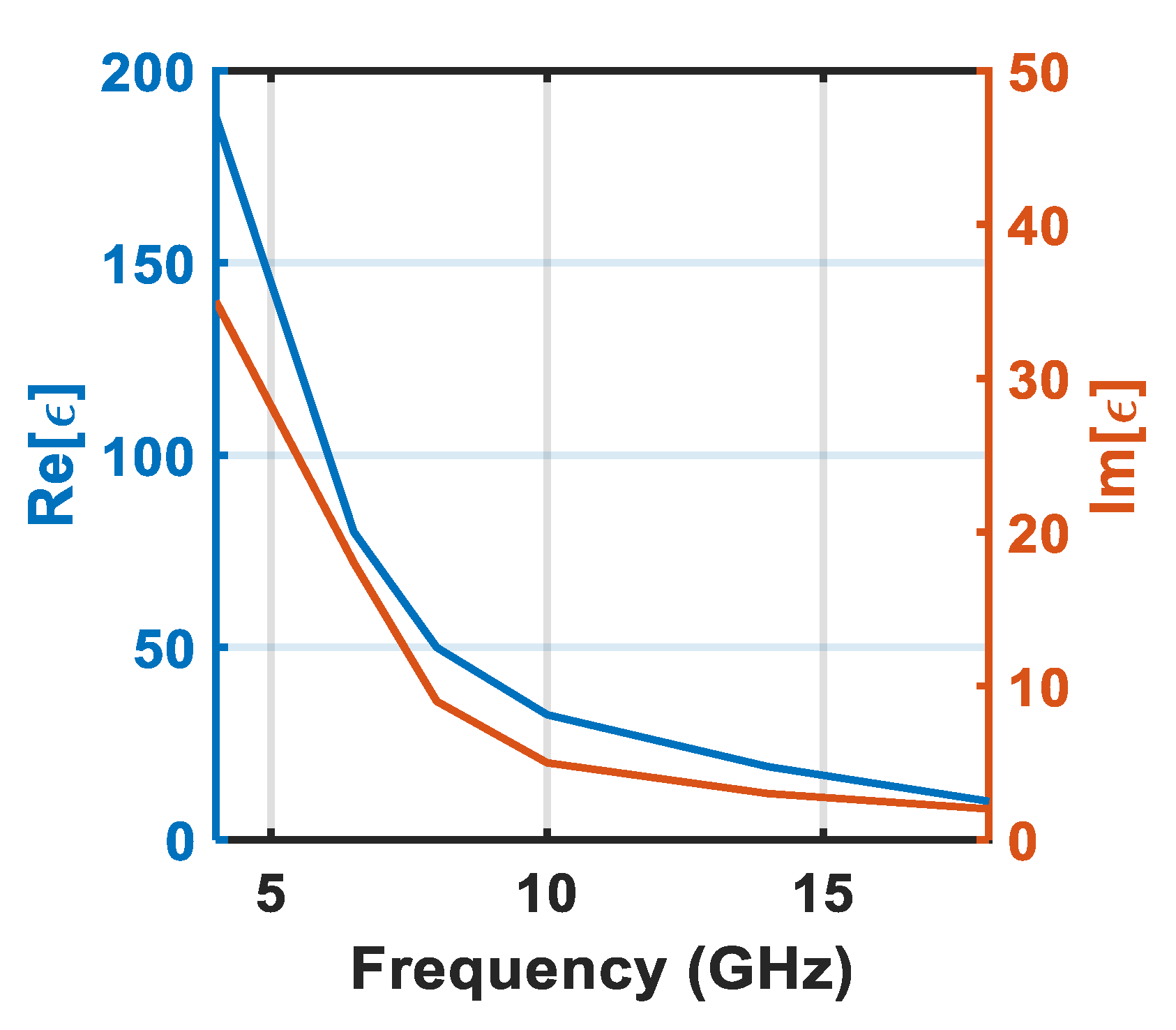

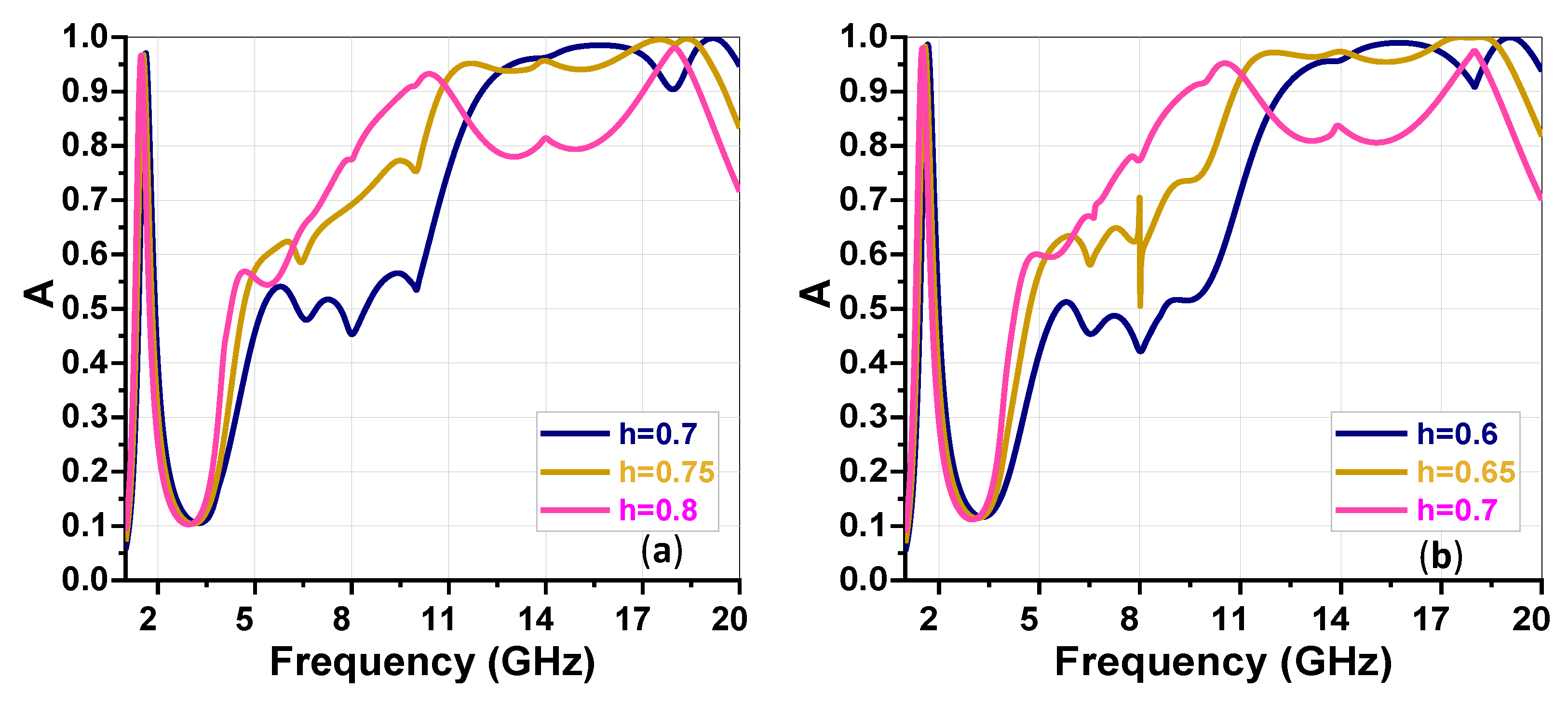
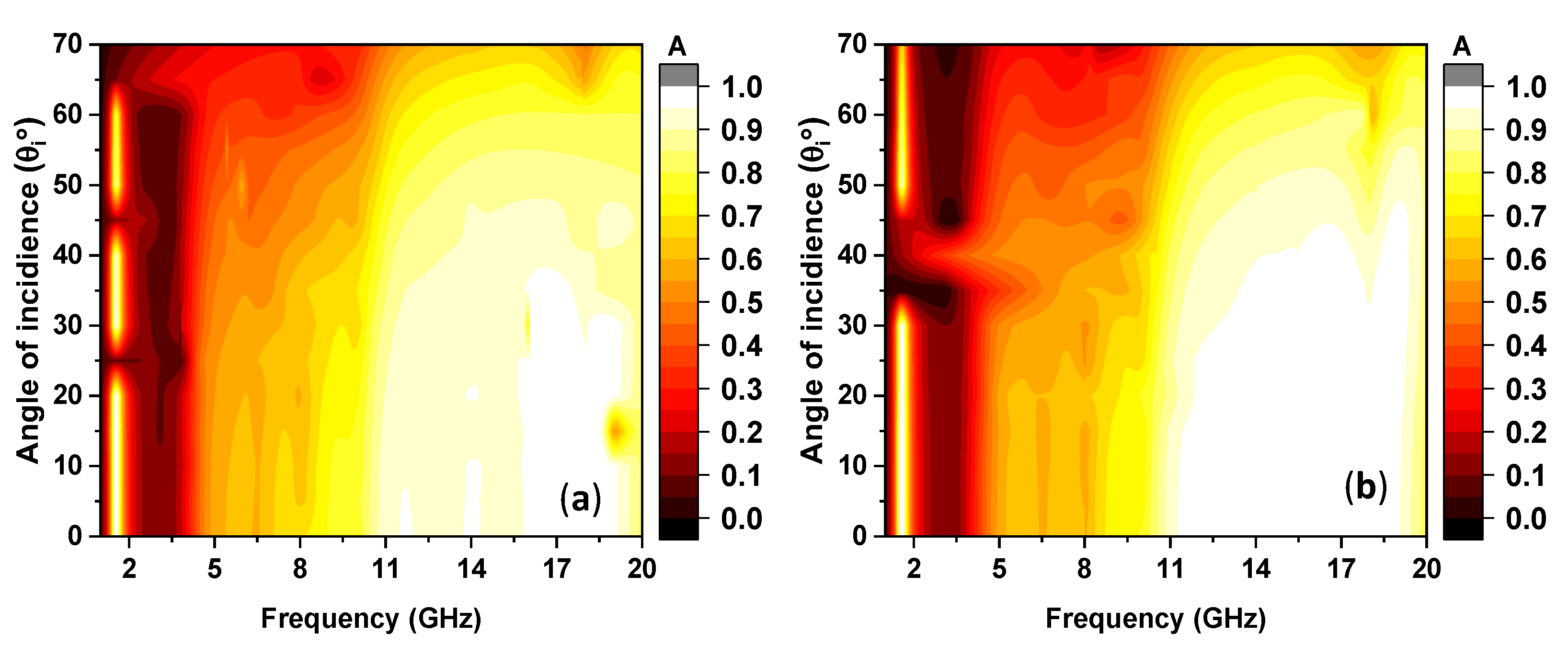

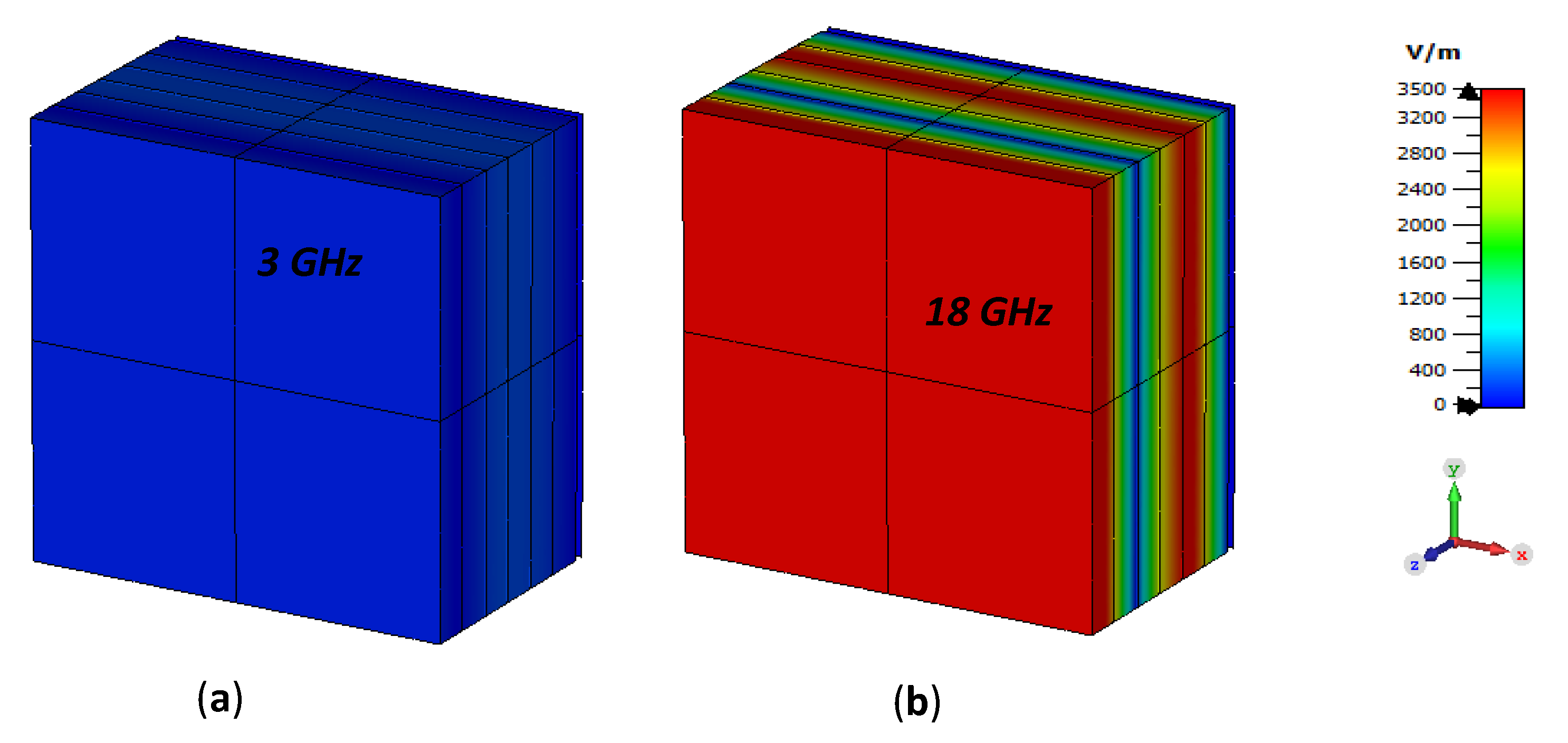
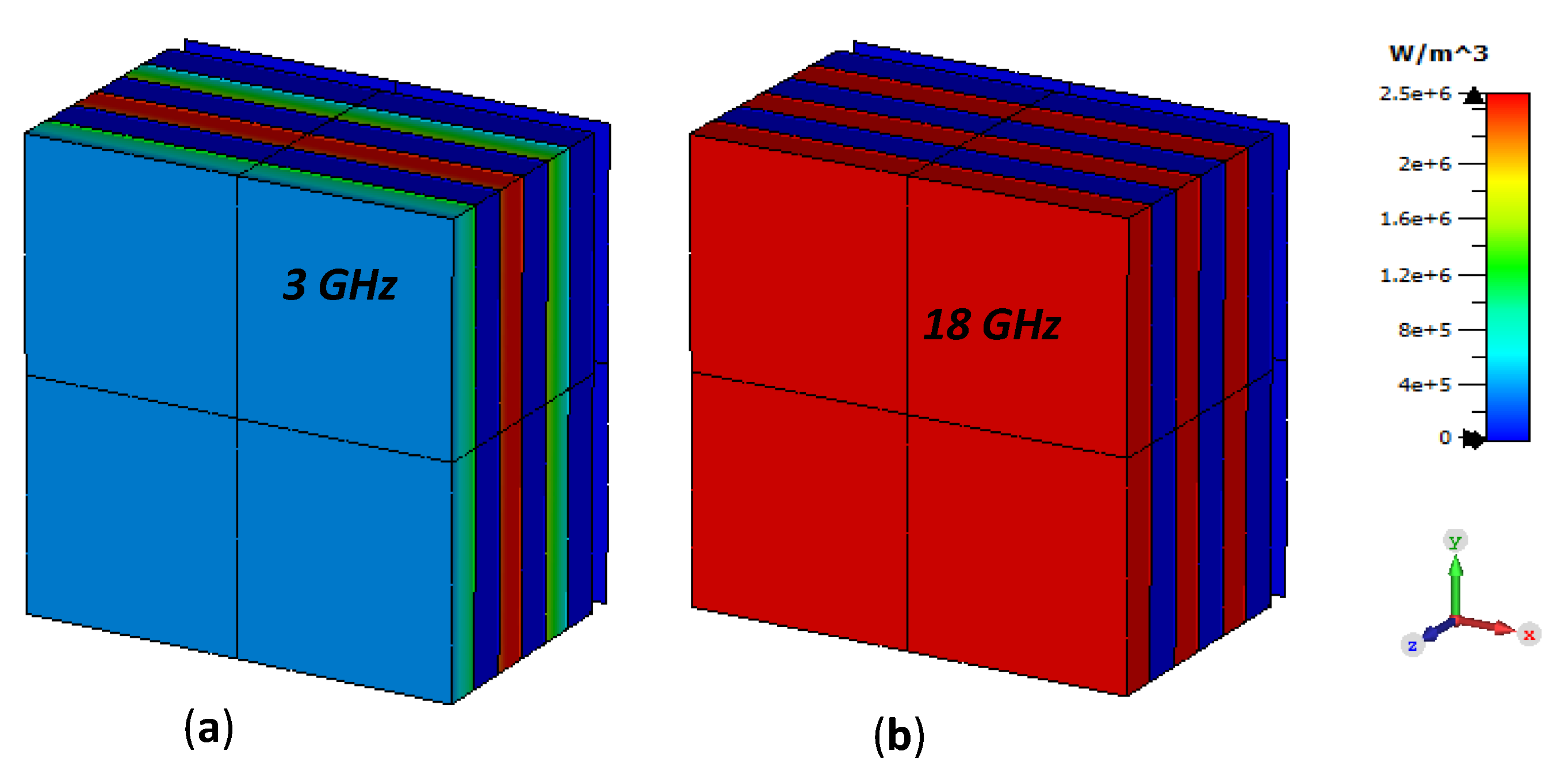

| Ref. # | Operating Frequency | Thickness | Angular Stability | Configuration | Investigation | Comments |
|---|---|---|---|---|---|---|
| [23] | 2–16 GHz | 2 mm | θi ≤ 20° | FSS | Full-wave simulation | Selective absorption, Simple structure, unfit for HPM |
| [43] | 6–30 GHz | 4 mm | θi ≤ 45° | Couple of FSS, and air spacer | Simulation and measurement | Simple fabrication, wide bandwidth, unfit for HPM |
| [44] | 7–44 GHz | 4.05 mm | θi ≤ 30° | Coding metamaterial | Simulation and measurement | Complex structure, wide bandwidth, unfit for HPM |
| [20] | 4–16 GHz | 6.5 mm | θi ≤ 50° | FSS and layered materials | Simulation and measurement | Relatively easy fabrication, medium bandwidth, unfit for HPM |
| [18] | 1–8 GHz | 12 mm | θi ≤ 45° | FSS, inductive grid, and two air spacers | Simulation and measurement | Complex structure, less bandwidth, unfit for HPM |
| This work | 1–20 GHz | 5 mm | θi ≤ 50° | Layered structure | Full-wave simulation | Simple structure, ultra-wide bandwidth, suitable for HPM |
Disclaimer/Publisher’s Note: The statements, opinions and data contained in all publications are solely those of the individual author(s) and contributor(s) and not of MDPI and/or the editor(s). MDPI and/or the editor(s) disclaim responsibility for any injury to people or property resulting from any ideas, methods, instructions or products referred to in the content. |
© 2024 by the authors. Licensee MDPI, Basel, Switzerland. This article is an open access article distributed under the terms and conditions of the Creative Commons Attribution (CC BY) license (https://creativecommons.org/licenses/by/4.0/).
Share and Cite
Sheta, E.M.; Sutinjo, A.T. Layered Structure Based on PANi and SiO2 to Absorb HPM to Protect Systems and Devices. Crystals 2024, 14, 391. https://doi.org/10.3390/cryst14050391
Sheta EM, Sutinjo AT. Layered Structure Based on PANi and SiO2 to Absorb HPM to Protect Systems and Devices. Crystals. 2024; 14(5):391. https://doi.org/10.3390/cryst14050391
Chicago/Turabian StyleSheta, Essameldin M., and Adrian T. Sutinjo. 2024. "Layered Structure Based on PANi and SiO2 to Absorb HPM to Protect Systems and Devices" Crystals 14, no. 5: 391. https://doi.org/10.3390/cryst14050391






